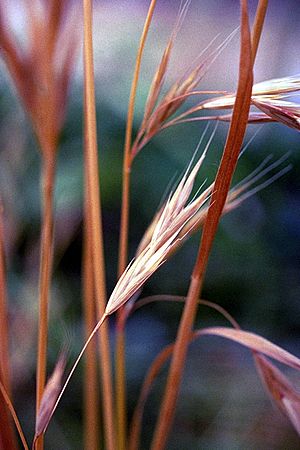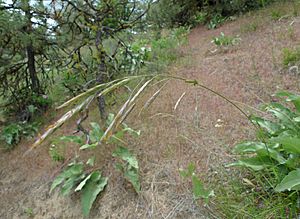California brome facts for kids
Quick facts for kids California brome |
|
|---|---|
 |
|
| Scientific classification | |
| Genus: |
Bromus
|
| Species: |
carinatus
|
| Synonyms | |
|
|
Bromus carinatus is a type of grass often called California brome or mountain brome. It is a common plant found in many parts of western North America. This grass is known for growing in clumps and can be quite tall.
Where It Grows
This grass naturally grows in western North America. You can find it from Alaska all the way down to northern Mexico. It lives in many different kinds of places. Sometimes, it also grows in the central and eastern parts of North America. There, it is considered an introduced species, meaning it was brought there by people.
What It Looks Like
Bromus carinatus is a perennial bunchgrass. This means it lives for more than two years and grows in clumps. These clumps can be from about 0.5 to 1.5 meters (about 1.5 to 5 feet) tall. It has many thin leaves that can be up to 40 centimeters (about 16 inches) long.
The flowers of this grass grow in a wide or drooping cluster called an inflorescence. The individual flower parts, called spikelets, are flat and longer than they are wide.
How It Reproduces
This grass is mostly pollinated by the wind. But sometimes, its flowers can pollinate themselves. This is called cleistogamy, and it often happens when the plant is under stress. The grass can also grow new plants from its roots and stems. This is known as vegetative reproduction using tillers.
This type of grass can look very different depending on where it grows. It can sometimes be hard to tell apart from other similar grasses like B. catharticus and B. stamineus.
How People Use It
This grass is useful for controlling erosion, which is when soil washes away. It is also used to help damaged land grow plants again. Farmers often use it as food for their livestock because animals like to eat it. However, it can sometimes grow too much and become a noxious weed in farm fields.
See also
 In Spanish: Bromus carinatus para niños
In Spanish: Bromus carinatus para niños


